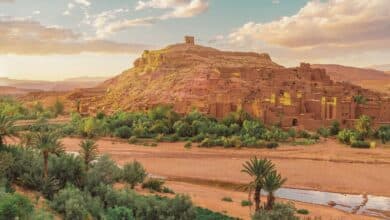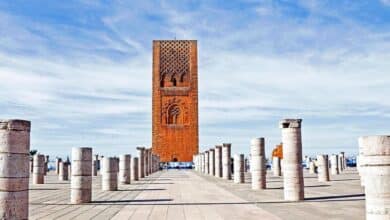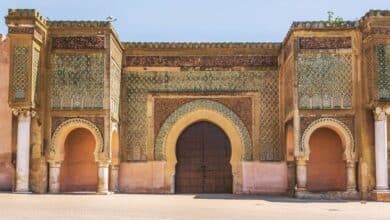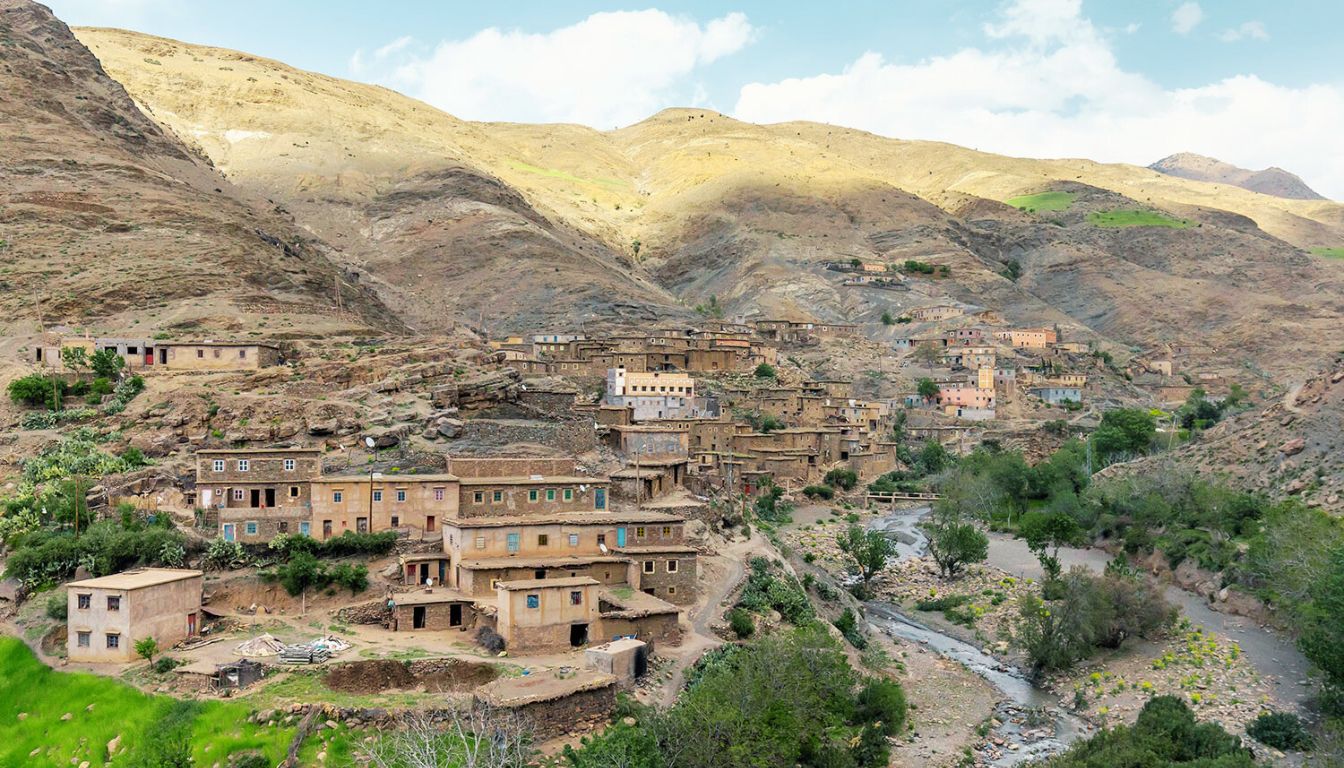
Unique Experience in the Draa Valley
The Draa Valley attracts hikers from all over the world. It is located between Ouarzazate and Zagora, accessible via the N9 highway. This region of southern Morocco is renowned for its magnificent landscapes, ranging from oases to deserts.
The Draa River, which flows from the Atlas Mountains into the Atlantic Ocean, flows through the region, creating a mosaic of vegetation and arid lands. Visitors can visit ancient villages such as Agdz and M’hamid El Ghizlane. They discover orchards, palm groves, and traditional kasbahs.
This region, rich in history and landscapes, prospered thanks to trans-Saharan trade. It is home to impressive sites such as the Foum Chenna rock art site. Planning a travel experience in the Draa Valley is a dream for lovers of discovery and hiking.
Discovery of the Draa Valley: Between Oasis and Desert
Morocco’s Draa Valley is a place where the abundance of oases meets the vastness of the desert . The Draa River feeds this region, offering a striking contrast. Berber caravan trails lead to Timbuktu.
Travelers can arrive via the N9 road or at Ouarzazate Airport, 170 km from M’Hamid. Along the way, they will pass through Agdz, 55 km away, or Zagora, 95 km away. These roads offer beautiful views, from mountains to 300-meter-high sand dunes.
It is possible to discover lesser-known trekking trails or take 4×4 excursions from Tansikht to Zagora. This offers a unique view of the draa . Agdz, 6 km from Tamnougalt, is home to an impressive kasbah, testifying to the valley’s past.
Despite its tourism, the Draa Valley retains its authenticity. The palm grove of the Oued Drâa , which stretches over 200 km, surrounds the towns and villages. It offers places for relaxation and discovery, such as the pottery of Tamegroute and the Zagora Museum.
Unforgettable Activities in the Draa Valley
The Draa Valley is a magical place for nature lovers. It is ideal for those who enjoy hiking or trekking in the Draa . The landscapes are so beautiful that they welcome you with open arms.
For those seeking thrills, the 4×4 option is perfect. It allows you to dive into the desert and discover oases . You can even have tea with nomads and enjoy a unique moment on the dunes.
4×4 treks in Morocco’s Draa Valley are a blend of culture and nature. You’ll stay in hotels in Marrakech and spend nights under the stars. You’ll discover the daily lives of the locals and learn Berber.
Prices for these eight-day trips start at €800. They offer a combination of hiking, relaxation, and culture. You’ll stay in 3-star hotels, kasbahs, and overnight stays in tents. This guarantees a comfortable and memorable stay.
The Fascinating History of the Draa Valley
The history of the Draa Valley dates back several centuries. It was a major route for the trans-Saharan trade of gold, salt, and spices. In the 16th century, trade flourished there, making the valley an important economic and cultural center. The Ksar of Tissergate, built then, is a
Morocco’s Draa Valley is also known for its mud-brick watchtowers. These towers demonstrate the locals’ resistance to attack. They are still visible today, offering a glimpse into the region’s ancient life.
The Museum of Arts and Traditions, in the Ksar of Tissergate, displays a collection of jewelry, utensils, and costumes. This highlights the historical and cultural importance of the region. The 200-kilometer-long valley has always been strategic for trade and cultural exchange.
The town of Zagora, in the heart of Morocco’s Draa Valley , is surrounded by kasbahs and bustling markets. The Ksar Museum offers a glimpse into the region’s evolution.
The historical heritage of the Draa Valley is a treasure trove for those who wish to discover its culture and economy. Every element, from the ksours to the markets, tells a part of its fascinating story.
For more information, visit the Draa Valley blog. It’s a site full of information about this iconic region.
The Kasbahs and Ksars of the Draa Valley
The kasbahs and ksars of the Draa Valley are architectural and cultural treasures. On the road from Agdz to M’Hamid, you’ll discover palm groves adorned with these beautiful structures. The Kasbah of Agdz, or Kasbah of Caïd Ali, and the 16th-century Ksar Tamnougalt showcase the valley’s richness.
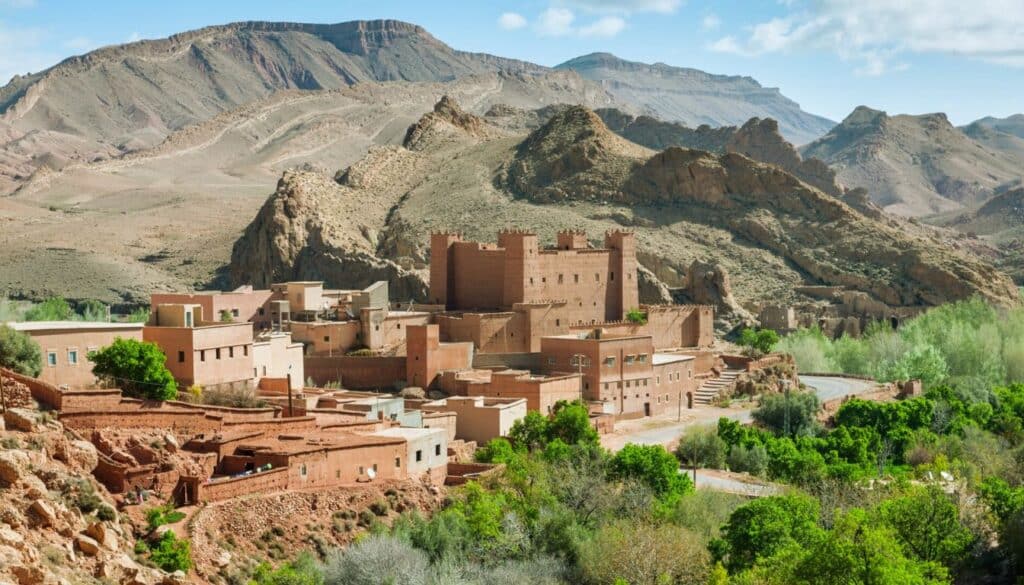
These buildings blend seamlessly with the Draa Valley landscape. They offer a journey through the region’s history and architecture. The kasbahs showcase the skill of local artisans and their historical heritage.
UNESCO-recognized Ksar Ait Ben Haddou is a must-see. It is famous for its history and was filmed in “Gladiator” and “Lawrence of Arabia.”
The Draa Valley Through the Seasons
The Draa Valley stretches for approximately 200 kilometers along the Nationale 9 road. It offers a variety of landscapes and climatic contrasts throughout the year. The climate varies greatly with the seasons, which influences the best times to visit.
The region is very hot in summer. Winters are milder with cool nights. The months from October to early May are perfect for exploring the region. This is the perfect time to hike and discover the nature and culture of the oases .
The Draa Valley is an example of sustainable tourism . Many come for the camel trek in the Sahara, which can last up to three days. This allows you to immerse yourself in this magnificent landscape. The world’s largest palm grove, stretching over 230 km, is a highlight.
The Tinfou Dunes, reaching 120 meters high, offer incredible views. They are accessible after a five-hour hike. Jebel Kissane, at 1,485 meters, attracts hikers seeking adventure.
Tours in the Draa Valley are designed for small groups of 4 to 15 people. They offer a personalized and authentic experience. A French-speaking Moroccan guide, a team of camel drivers, and a local chef ensure a memorable experience.
The Hidden Treasures of the Draa Valley
The Draa Valley is recognized by UNESCO as a biosphere reserve . It offers a range of hidden treasures . The Tizri waterfalls are among the most beautiful, with their peaceful atmosphere. It is a perfect place for those seeking tranquility.
The Tizri Waterfalls are nearby and offer a relaxing break. Visitors can swim and even drink tea under the rocks. In the Draa Valley , oases are essential for the local flora and fauna.
The Tizri waterfalls
The Tizri waterfalls are a treasure of the Draa Valley . They showcase the region’s cultural and historical richness. Along with the Ksar Aït Ben Haddou and the Foum Chenna paintings, they are a must-see.
For adventurers and nature lovers, the Tizri waterfalls offer an unforgettable experience. The Draa Valley is full of hidden treasures to discover.
Conclusion
The Draa Valley, a natural and cultural treasure in Morocco, is more than just a tourist attraction. With less than 100 mm of precipitation per year, it demonstrates the strength of nature in the face of harsh conditions. The 1970s to 1990s saw changes in the landscape and communities, with agriculture and livestock raising as the main sources of income.
Fortified villages like Tiraf, protected by the Ait ‘Atta confederation since the 19th century, tell the valley’s history. The oases of Ktaoua and Mhamid demonstrate the region’s environmental and economic challenges.
Archaeological research has revealed significant occupation of the valley between the 4th and 6th centuries AD. Complex settlements and cairn cemeteries have been found. These discoveries demonstrate the importance of trans-Saharan trade and irrigated agriculture in the region’s history.
The Draa Valley offers a unique experience to its visitors. Visitors can visit historic kasbahs and sample Berber cuisine. With Morocco Shiny Days, travelers discover the authenticity and traditions of this unique place. The Draa Valley is a natural and cultural treasure, full of riches to discover.

